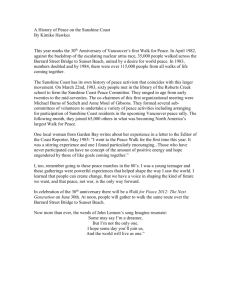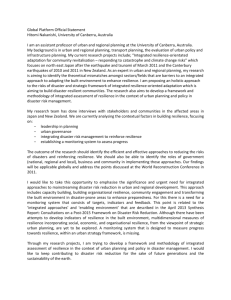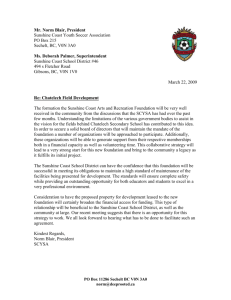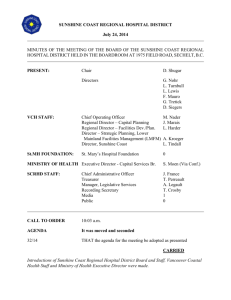Appendix G - Events Website
advertisement
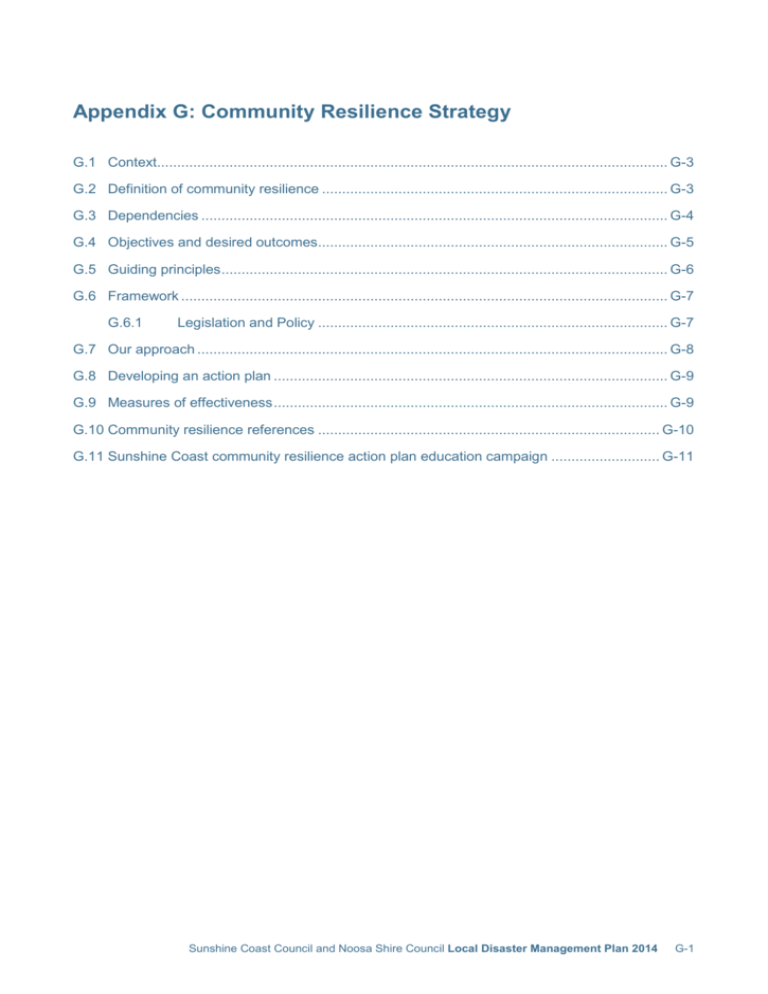
Appendix G: Community Resilience Strategy G.1 Context............................................................................................................................... G-3 G.2 Definition of community resilience ...................................................................................... G-3 G.3 Dependencies .................................................................................................................... G-4 G.4 Objectives and desired outcomes....................................................................................... G-5 G.5 Guiding principles ............................................................................................................... G-6 G.6 Framework ......................................................................................................................... G-7 G.6.1 Legislation and Policy ....................................................................................... G-7 G.7 Our approach ..................................................................................................................... G-8 G.8 Developing an action plan .................................................................................................. G-9 G.9 Measures of effectiveness .................................................................................................. G-9 G.10 Community resilience references ..................................................................................... G-10 G.11 Sunshine Coast community resilience action plan education campaign ........................... G-11 Sunshine Coast Council and Noosa Shire Council Local Disaster Management Plan 2014 G-1 THIS PAGE INTENTIONALLY LEFT BLANK G-2 Sunshine Coast Council and Noosa Shire Council Local Disaster Management Plan 2014 G.1 Context Australia has recently experienced a number of large scale and devastating natural disasters, including catastrophic bushfires, far reaching floods, cyclones and damaging storms. Natural disasters are a feature of the Australian climate and landscape and this threat will continue, with weather patterns likely to be less predictable and more extreme over coming years. The community is exposed to a range of other potential disasters, including urban and industrial fires, pandemics, aircraft crashes, major road accidents, marine oil spills, security incidents, and exotic animal and plant diseases. Such events may have personal, social, economic and environmental impacts that take many years to dissipate. Our unique climate, environment and demography means that we need to shape our resilience activities to suit our circumstances but within the context of being a part of the South East Queensland setting. Australians are renowned for their resilience to hardship. Complementing our ability to innovate and adapt, are a strong community spirit that supports those in need, and a general self-reliance to withstand and recover from disasters. In Queensland, we have well established and cooperative emergency and disaster management arrangements at the state, district and local levels delivering a coordinated approach and effective capabilities. Building community resilience requires effective community education and community participation. The fundamental building blocks of resilience for the Sunshine Coast are individuals and households. If at this level, people are aware of the risks and are prepared to respond and are connected to support networks, there is far greater resilience at the neighbourhood, community and regional levels. This results in a reduced reliance on emergency services and external resources in a disaster which in turn generates flexibility in formal response and recovery activities. In building community resilience on the Sunshine Coast, we are aiming to improve the safety of our communities day to day, as well as enhancing their preparedness for the most likely and frequent disaster scenarios and our capacity to deal with more extreme and unpredictable events. This strategy does not aim to replace initiatives being implemented by government departments, emergency service organisations, and other agencies; rather it aims to leverage the resources provided through them and complement the overall strategies with activities at the local and regional level. G.2 Definition of community resilience Community resilience is a community’s capacity to change, grow and flourish whatever circumstances it finds itself in. A disaster resilient community not only knows the risks and hazards they face but also has the ability to recover from the aftermath of such events and the impacts on their lives. Disaster resilient communities are also aware that it may take considerable time before life returns to any degree of normality should an event impact their area. Resilience is not simply about a community going back to what it was like before but rather learning from the event and adjusting to be better prepared should a similar event occur again. Sunshine Coast Council and Noosa Shire Council Local Disaster Management Plan 2014 G-3 G.3 Dependencies A resilient Sunshine Coast depends upon: G-4 Individual and collective experience and responsibility: The ability of people and groups to live through and recover from disasters, identify strengths and weaknesses in how they responded and apply their experiences, observations and learnings to future events. Personal health and wellbeing: A community that has a high level of overall fitness and mental wellbeing and a low dependency on healthcare services is better able to manage the physical and emotional demands of a disaster event. Awareness of risks: The community has access to current, relevant and localised information on what the risks are in their area. A well informed community is a risk aware community. Access to social networks: A high degree of accessibility to and membership of informal and formal local and social networks allows for greater mutual support and assistance being provided at the lowest level. Networks may include family, friends and social networks, school or church based groups, local formal clubs (such as RSL, Lions and Apex) or sporting clubs. Access to infrastructure: A high degree of surety in supply of essential services through maintaining robust infrastructure is a measure of a community’s resilience. Access to clean drinking water, health services, power, food and security are important considerations in disaster management planning and response. Access to communication networks: Community members have access to reliable means of communication. This allows for the effective passage of information to community members (such as alerts, warnings and advice from authorities) and information from community members (such as requests for assistance or advising status to family and friends). Communication networks may include face to face contact, telephone services (voice and text), email, social network sites and radio and television networks. Good Governance: Community members have confidence in the leadership, authority, structures and capabilities that contribute to minimising the impact on the community during all phases of a disaster. This includes federal, state and local government agencies, emergency services and local leaders (including school and church group leaders). Sunshine Coast Council and Noosa Shire Council Local Disaster Management Plan 2014 G.4 Objectives and desired outcomes Our objectives in developing this strategy are to: Improve awareness Desired outcomes Residents and visitors: 1. are aware of the natural and human-made hazards and associated risks and how they may impact on them and others in the community. 2. have access to comprehensive information about the risks at the local level, can identify the indicators of a disaster event and know how to get official warnings and alerts. 3. know their own and their neighbours strengths and weaknesses in relation to preparing for and responding to a disaster event. 4. feel empowered to make decisions and take actions to protect themselves, their families and those around them. Enhance preparedness Desired outcomes Individuals, families and local businesses: 5. anticipate disasters and act to protect themselves, their assets and their livelihoods, minimising physical, economic and social losses. 6. have the plans and resources in place to be self-sufficient for a minimum of three days. 7. are adaptive and flexible in responding to emergencies. 8. are willing to assist those less prepared or more vulnerable than themselves, including the young, elderly, people with disabilities, tourists, visitors, non-english speakers and recently arrived residents. Sunshine Coast Council and Noosa Shire Council Local Disaster Management Plan 2014 G-5 Build community networks Desired outcomes 1. Individuals have the means of communicating their situation and requesting or offering assistance to family, neighbours or volunteer organisations. 2. Community assets, leadership, networks and resources are leveraged to achieve a collective preparedness and response to a disaster. 3. Local people are capable of organising themselves before, during and after disasters in order to restore social, institutional and economic activity. 4. Formal and informal support networks are available to individuals, families and businesses in a time of crisis. 5. The community works in partnership with emergency services, local authorities and relevant organisations, ensuring safe and complementary efforts. G.5 Guiding principles The guiding principles are: An engaged community where individuals, small groups and authorities work towards common goals Accessibility of information and resources Mutual support The protection of critical infrastructure The preservation of the environment G-6 Sunshine Coast Council and Noosa Shire Council Local Disaster Management Plan 2014 G.6 Framework This strategy sits within the National Strategy for Disaster Resilience, the ‘Building a More Resilient Queensland’ concept and the draft proposed framework ‘Fostering Community Resilience using the Principles and Processes of Community Engagement’ document being prepared by the Queensland Department of Community Safety through Queensland Fire and Emergency Services (DM) (QFES (DM)). It is also consistent with Council’s own community engagement framework. Figure 5: Community resilience strategy framework G.6.1 Legislation and Policy The Disaster Management Act 2003 (The Act), amended on 1 November 2010, forms the legislative basis for disaster management activities within all levels of Government in Queensland. The Act allows for formal declaration of a disaster and activation of response mechanisms by Government at the state, district and local levels. The Public Safety Preservation Act (1986), amended on 1 November 2010, provides for the protection of members of the public in terrorist, chemical, biological, radiological or other emergencies that create or may create danger of death, injury or distress to any person, loss of or damage to any property or pollution of the environment. This Act allows for declaration of an emergency situation and use of special powers by authorities when an emergency situation is declared. State Planning Policy 1/03 sets out the State’s interest in ensuring that the natural hazards of flood, bushfire, and landslide are adequately considered when making decisions about development. The policy provides for enhanced resilience through requiring the identification of natural hazard management areas and the implementation of appropriate controls through planning schemes. Sunshine Coast Council and Noosa Shire Council Local Disaster Management Plan 2014 G-7 G.7 Our approach The Sunshine Coast approach to resilience is based on the four core pillars of community, infrastructure, environment and governance. Each pillar encapsulates a range of systems, processes and resources that may contribute to resilience to any given scenario or event. Where the four pillars integrate effectively, resilience is at its strongest. The approach also recognises the differences in characteristics and risk exposures between the coastal, urban, rural, remote environments. Figure 6: Sunshine Coast approach to resilience G-8 Sunshine Coast Council and Noosa Shire Council Local Disaster Management Plan 2014 G.8 Developing an action plan In order to achieve the objectives and desired outcomes, council will develop an action plan to be delivered over a period of years which seeks to ultimately Enhance knowledge and empower local communities: Residents and visitors to the Sunshine Coast will develop the knowledge to make informed decisions and are empowered to act for the immediate safety of themselves, those around them and the vulnerable segments of the population. Change attitudes: The population accepts that greater preparation, self-sufficiency and interdependence at the individual, family, street and neighbourhood level increases the ability of authorities to effectively direct scarce emergency resources. Modify behaviour: Proactive planning, sound preparation and contributing to a coordinated response to disaster events become normal activities within the community. Improve skills: Community members and organisations develop the appropriate skills to provide an effective response to and recovery from disaster events that may affect their environs. Specific actions for each of the objectives will be outlined in a community resilience action plan to be developed by the community resilience officer and community education officer (disaster management). The action plan will be marketed through a community education campaign which asks individuals to be aware, prepare and connect The key to the successful delivery of these programs will be the coordinated involvement of key representatives of emergency services agencies on the Sunshine Coast through the LDMG’s community awareness and preparedness sub-group. In addition, wherever possible the community will be invited to contribute by providing relevant and practical ideas, observations and requests that will contribute to the regional ability to adapt and respond to future disasters. G.9 Measures of effectiveness The Sunshine Coast will broadly adopt the community readiness model outlined in the State Government’s draft proposed framework ‘Fostering Community Resilience using the Principles and Processes of Community Engagement’. This will provide an indication of maturity and capacity at the locality level. Sunshine Coast Council and Noosa Shire Council Local Disaster Management Plan 2014 G-9 G.10 Community resilience references Bureau of Meteorology Website – Sunshine Coast Weather Data Council of Australian Governments (COAG) National Strategy for Disaster Resilience Building our nation’s resilience to disasters (2011) Draft proposed framework ‘Fostering Community Resilience using the Principles and Processes of Community Engagement’ document being prepared by the Department of Community Safety through QFES (DM). Emergency Volunteering ‘Step Up’ program for Small Business Resilience and Continuity Emergency Volunteering Disaster Readiness Index QFES (DM) Guidance on Business Continuity Planning Household Emergency Kit List (QFES (DM) Website) Household Emergency Plan Template (QFES (DM) Website) Noosa Climate Action Plan Queensland Fire and Emergency Services (Fire) (QFES (FIRE)) Bushfire Fire Readiness Campaign (Prepare Act Survive) Queensland Reconstruction Authority – rebuilding a stronger, more resilient Queensland (September 2011) Sunshine Coast Community Information Services (CIS) Sunshine Coast Local Disaster Management Plan Sunshine Coast Region – 44 Localities Map G-10 Sunshine Coast Council and Noosa Shire Council Local Disaster Management Plan 2014 G.11 Sunshine Coast community resilience action plan education campaign The purpose of this campaign is to build awareness, preparedness and connectivity amongst the people of the Sunshine Coast to enhance community resilience. It asks individuals to be: Figure 7: Sunshine Coast community resilience action plan education campaign Acknowledgement: This Community Resilience Strategy was prepared by GHD Pty Ltd working with the SCLDMG and funded with the assistance of a Natural Disaster Resilience Program Grant Sunshine Coast Council and Noosa Shire Council Local Disaster Management Plan 2014 G-11 THIS PAGE INTENTIONALLY LEFT BLANK G-12 Sunshine Coast Council and Noosa Shire Council Local Disaster Management Plan 2014


